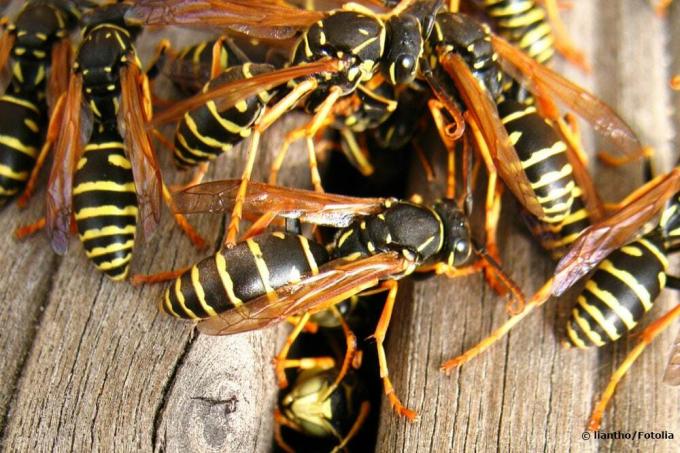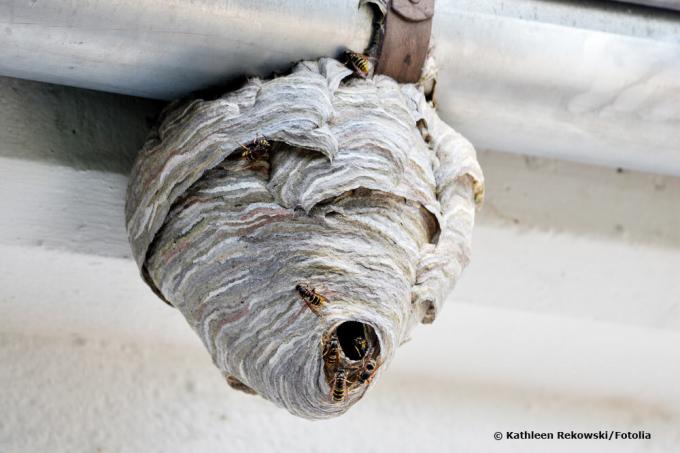
table of contents
- Important: differentiate between species
- Real wasps (Vespinae)
- Field wasps (Polistinae)
- Cuckoo wasps
- Leaving the nest
- Early dissolving species
- Late dissolving species
Oh my godness! You just wanted to get something from your attic and suddenly you encounter a colony of wasps that have nested there. A wasp's nest is something uncomfortable for many people, as the wasps can sting and are considered to be quite aggressive. Here you have the option of removing the nest or waiting for the animals to leave their hiding place. It is good to know when the insects will disappear.
Important: differentiate between species
Before the important "dates" for leaving the nest can be explained, it is important to know which wasps are found in Germany and Central Europe. The reason for this is that wasp species too different times leave the nests, which is crucial for the waiting time to remove the nests independently.
There are a total of 16 species of wasps (Vespidae) in Germany, which are structured as follows:
Real wasps (Vespinae)
Of the real wasps there are 9 species in Germany and Central Europe, whose nests are placed in a similar way. These are usually erected in dark cavities, well hidden or, less often, hanging in the open air. But many of these wasp species build their nests in the ground. The following types are included:
- Hornet (Vespa crabro)
- Asiatic hornet (Vespa velutina var. nigrithorax)
- Middle wasp (Dolichovespula media)
- Saxon wasp (Dolichovespula saxonica)
- Norwegian wasp (Dolichovespula norwegica)
- Wood Wasp (Dolichovespula sylvestris)
- German wasp (Vespula germanica)
- Common wasp (Vespula vulgaris)
- Red wasp (Vespula rufa)

Field wasps (Polistinae)
In comparison to the real wasps, the field wasps prefer sunny habitats, which are, however, protected and not easy to reach. These are mostly Cavities, more rarely about external locations. They include four types:
- House wasp (Polistes dominula)
- Heath Field Wasp (Polistes nimpha)
- Petite field wasp (Polistes bischoffi)
- Mountain wasp (Polistes biglumis)

Cuckoo wasps
The cuckoo wasps are variants of three species within the real and field wasps. These live parasiticby one queen killing the other and taking over the nest. After that, the queen replaces the entire colony. These social parasites include:
- False cuckoo wasp (Dolichovespula adulterina): it is a social parasite of the Saxon wasp
- Austrian cuckoo wasp (Vespula austriaca): it is a social parasite of the red wasp
- Mountain field wasp cuckoo wasp (Polistes atrimandibularis): it is a social parasite of the mountain field wasp
Leaving the nest
All of these species build a wasp nest that can be near your living quarters, in the garden, or on your property in general. Cuckoo wasps are actually the same species of wasp, but they do not build the nest themselves. However, their way of life is the same. The 16 types can now be found in two groups split up, each pursuing other dates in relation to leaving the nest:
- early dissolving species
- late dissolving species
The comparison between these two groups is important because it will decide when you can remove the nest and when the animals are no longer in danger. The process is the same for all types, only the dates differ significantly, which requires careful consideration.

The wasp nest is not occupied by the animals all year round, but rather before winter they move out at the latest. Because of this way of life, it is possible to create a wasp's nest in winter removewithout legal problems or dangerous stitches waiting for you.
tip: Do not confuse wasps and hornets with bees if you want to remove the nest over the winter. Bees overwinter in the hive and must not be disturbed during the cold season, otherwise there will be a heavy fine of at least 50,000 euros because they are under species protection.
Early dissolving species
The early dissolving species represent the greater part of the wasp species in Central Europe. In this group there are a total of 12 species that dissolve much earlier than the second group so that the young queen can reproduce and look for winter quarters. These types are:
- Middle wasp (Dolichovespula media)
- Saxon wasp (Dolichovespula saxonica)
- Norwegian wasp (Dolichovespula norwegica)
- Wood Wasp (Dolichovespula sylvestris)
- Red wasp (Vespula rufa)
- House wasp (Polistes dominula)
- Heath Field Wasp (Polistes nimpha)
- Petite field wasp (Polistes bischoffi)
- Mountain wasp (Polistes biglumis)
- False cuckoo wasp (Dolichovespula adulterina)
- Austrian cuckoo wasp (Vespula austriaca)
- Mountain Field Wasp Cuckoo Wasp (Polistes atrimandibularis)
All of these wasps are much more sensitive to it cool temperatures and for this reason withdraw from the wasp's nest quite early in the year. For this reason, the young queens also have to fly out earlier for fertilization so that they are not exposed to the cooler temperatures in autumn.

On average, the old queens leave the wasp nest mid August, followed by the young queens a short time later. Since the young queens are not yet able to lay fertilized eggs, the last workers die about four weeks after leaving the old queen, due to undersupply as well dies. The date for the leaving nest varies as follows:
- end of August
- first week of September
- Mid-September
As with all wasp species, however, some workers may survive longer and try to raise the last of the young queens. For this reason, the most suitable for removing the nests in this group is the Beginning of winter at.
Note that there are many wasp nests in cooler regions in German-speaking countries end of August are almost completely empty. The Alpine region and the Ore Mountains in particular should be mentioned here. There the temperatures are so low earlier that the queens swarm out very early, which gives you the opportunity to act earlier against the old wasp's nest.
Late dissolving species
The remaining four species, which are the largest native and immigrant, as well as the most common wasps in Central Europe, belong to the late-dissolving species:
- Hornet (Vespa crabro)
- Asiatic hornet (Vespa velutina var. nigrithorax)
- German wasp (Vespula germanica)
- Common wasp (Vespula vulgaris)
In most cases you will find a wasp nest of these species close by. Because of this, the dates for this group are even more important to you. With these species it is noticeable that they dissolve the colony quite late and even right resistant to the first frosts are. This is mainly due to the size of the hornets and the robustness of the German and common wasps.

The old queens swarm Mid-September to early October out and the young ones follow about two weeks later. After that, the death of the last female workers is heavily dependent on the frosts in the individual federal states:
- Baden-Württemberg: mid-October
- Bavaria: mid-October, less often the first week of October
- Berlin and Brandenburg: beginning of November
- Hesse: end of October, less often in mid-October
- Mecklenburg-Western Pomerania: beginning of November
- Lower Saxony with Bremen: beginning of November
- North Rhine-Westphalia: mid-October
- Rhineland-Palatinate: mid to late October
- Saarland: mid to late October
- Saxony: beginning of November in the north of Saxony, beginning of October in the Ore Mountains
- Saxony-Anhalt: mid-October
- Schleswig-Holstein with Hamburg: mid-November
- Thuringia: end of October
The majority of this group of wasps dies in Switzerland and Austria end of October. In the case of wasps, which dissolve late, it is advisable not to remove the nests until late in winter. With this you can up end of January wait just to be on the safe side so that no wasps are alive.
tip: if you are not sure which wasp species it is, it is best to contact a specialist. Because this can give you precise information about the type of wasp.



